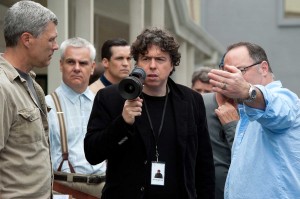
Gervasi burst on the directorial scene with his documentary Anvil! The Story Of Anvil (2008), and has previously written scripts, most notably The Terminal (2004) and Henry’s Crime (2010). After viewing Anvil the producers of Hitchcock knew Gervasi would be an ideal director for the project. Hitchcock, based on the book Alfred Hitchcock and The Making of Pyscho by Steven Rebello, has been in the making for several years but it was when Gervasi hopped on board to direct that it found its voice.
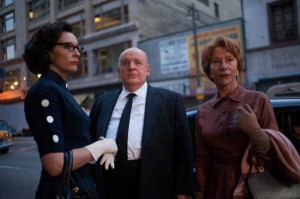
The humorous, absurd and poignant world of Hitchcock: the man, the legend, the icy blondes, the films, and at the heart of it, the love story between the director and his wife, was cleverly unveiled under Gervasi’s direction. The director believes the success of the film can be attributed to having the right cast, Anthony Hopkins as Hitchcock and Helen Mirren as Alma to be certain, but also the perfect below-the-line crew. For Gervasi, finding brilliant collaborators and trusting them to do their job is paramount. “We had real serious people who threw themselves heart and soul into the project.”
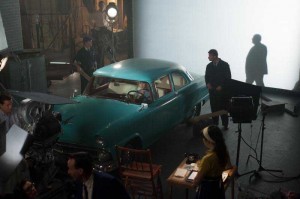
It was important to Gervasi to create the atmosphere of an old English theatre troupe among his key collaborators, all of whom began as strangers, and to submerse them into the soul of the material. He decided to take some creative measures. “No one really knew each other,” said the director. “When you start a movie you have the actors read the parts and you have a table reading with the actors. So I did that, but I also had a table reading with my department heads playing the parts in the movie which people said they hadn’t done before, so for example, I had costume designer Julie Weiss read the serial killer Ed Geins. It was fantastic.”
To help re-imagine the bold, the strange and sometimes terrifying visual world of Hitchcock, Gervasi enlisted director of photography Jeff Cronenweth. The film’s palette was a blend of several different looks. Besides the fitting glamour of Hollywood, Gervasi also arranged the film with gritty fantasies of Hitchcock befriending the real life serial killer Ed Geins, who served an as his inspiration for Psycho. “It was about having the Technicolor look of the period and also the darkness of the Geins story and this quaint English house, sort of merchant ivory type of Hitchcock’s home,” Gervasi commented. “We story boarded, we looked at color, Jeff worked really closely with Judy Becker and Julie Weiss, so it was a real team effort.”
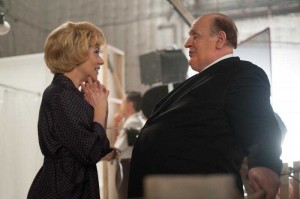 Gervasi also worked closely with production designer Becker to rebuild history. After all, this is a film about the making of Psycho, so of course, the set of Psycho had to be resurrected, as well as all of Hitchcock’s other haunts. “In our production offices, we have these big walls of images for the whole movie, and we would just move things around,” Gervasi said of the conceptualizing process. “The great thing was that this was a real world. We had the world at the studio; we had the world of the beach house inMalibu; we had the world ofBeverly Hills andHollywood and all that. There were all real visual references for these things and they all sprung from reality so we just pulled from endless images and created this thing.”
Gervasi also worked closely with production designer Becker to rebuild history. After all, this is a film about the making of Psycho, so of course, the set of Psycho had to be resurrected, as well as all of Hitchcock’s other haunts. “In our production offices, we have these big walls of images for the whole movie, and we would just move things around,” Gervasi said of the conceptualizing process. “The great thing was that this was a real world. We had the world at the studio; we had the world of the beach house inMalibu; we had the world ofBeverly Hills andHollywood and all that. There were all real visual references for these things and they all sprung from reality so we just pulled from endless images and created this thing.”
Editing the film was a creative and improvisation affair where discoveries were made and changes to the original plan were inevitable. The goal was to skillfully weave Hitchcock’s iconic dry humor with the profound longings he felt in life and of course, there’s also the darkness of his fantasies. His only friend is Ed Geins, whom he imagines interacting with throughout the film. “It was about telling a story in the most efficient way possible and keeping things moving but also looking for those moments of human behavior. We were looking for something that was funny, emotional and dramatic. There was a specific tone for the film because it has surrealism, realism, hyper realism.” Gervasi found the most ideal editor in Pamela Martin who understood the many dimensions of the story. “It has darkness, it has comedy, so there’s a lot of different things going on, so in order to get that tone right, you have to have an editor who understands the dynamic range of human behavior and can go from comedy to drama.”
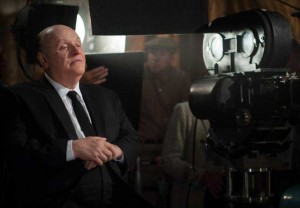 Dressing the glamorous Hollywood set of the 1960s demanded a costume designer with a profound understanding of the time period and the subtle dynamics of human interactions in that time. “Julie Weiss just believes in clothes as narrative so we got lucky. She’s like a professor of clothes.” Gervasi said of the costume designer. The director found it effortless to trust Weiss’ instincts implicitly. “She really understands everything. She grew up in L.A. in that era so she knew what coats the ladies wore, where they went for drinks and where they went for dinner, what they would wear in a certain club as opposed to another, the codes of behavior between men and women.”
Dressing the glamorous Hollywood set of the 1960s demanded a costume designer with a profound understanding of the time period and the subtle dynamics of human interactions in that time. “Julie Weiss just believes in clothes as narrative so we got lucky. She’s like a professor of clothes.” Gervasi said of the costume designer. The director found it effortless to trust Weiss’ instincts implicitly. “She really understands everything. She grew up in L.A. in that era so she knew what coats the ladies wore, where they went for drinks and where they went for dinner, what they would wear in a certain club as opposed to another, the codes of behavior between men and women.”
Music composer Danny Elfman appeared on set one day out of the blue. Gervasi had no idea who the gentleman watching behind the monitors was at first. When he discovered Elfman’s interest in the film, he was overjoyed. “The reason why Danny Elfman became a composer, according to him, is because Bernard Herrmann’s [Hitchcock’s musical collaborator] film music is what inspired Elfman. So the idea of us doing a movie about Alfred Hitchcock with Herrmann’s music was too irresistible to him,” said Gervasi. Elfman’s commitment to see the music through was an essential contribution. “He did a brilliant score. We flew to London to record it. We had no money. We could only keep the full orchestra up until lunch on the first day and as they were leaving, Danny said to his orchestrator Steve Bartek, ‘How much do the violas cost?’ and he said 3,000 pounds. Danny said ‘buy them.’ So you had Danny Elfman buying parts of the orchestra because he refused to compromise and he wanted it to be just right.”
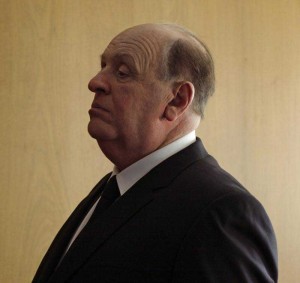 Even with his dream team, making the film was not without its obstacles. The making of the film was a whirlwind with everything happening all at once. Gervasi began his in-depth research with only two months before filming began, and at the same time his core group of collaborators were coming onto the project. From there, the process continued moving at a rapid pace. “I think the biggest challenge was time. We had no time. We had 35 days to shoot and we only started April 13 of this year so we did the whole thing end to end in six months from first day of principal to delivered movie.”
Even with his dream team, making the film was not without its obstacles. The making of the film was a whirlwind with everything happening all at once. Gervasi began his in-depth research with only two months before filming began, and at the same time his core group of collaborators were coming onto the project. From there, the process continued moving at a rapid pace. “I think the biggest challenge was time. We had no time. We had 35 days to shoot and we only started April 13 of this year so we did the whole thing end to end in six months from first day of principal to delivered movie.”
“It’s been an amazing experience,” Gervasi said. “For my first movie, I directed Anthony Hopkins and Helen Mirren working together for the first time in a story about one of my great all time heroes and we got to shine the story on his greatest collaborator ever, his wife, and I got the best people in the business to work with me so it was pretty dream scenario. I’ve got nothing to complain about.” Who wouldn’t want to watch a filmed expose on the ever fascinating and strange Alfred Hitchcock? Gervasi has made his grand debut just that and so much more as he navigated the legend’s personal story to reveal all his longings, dreams, and woes with an exquisite sensitivity.





